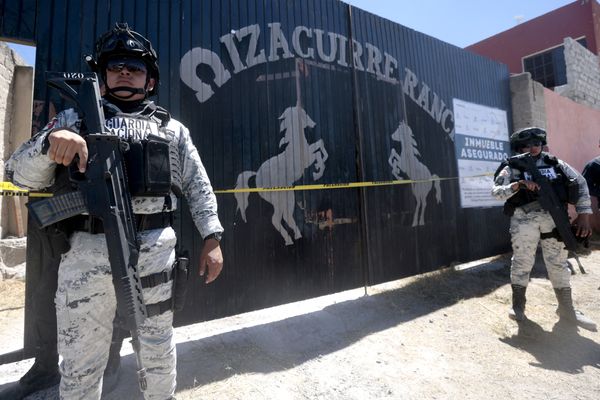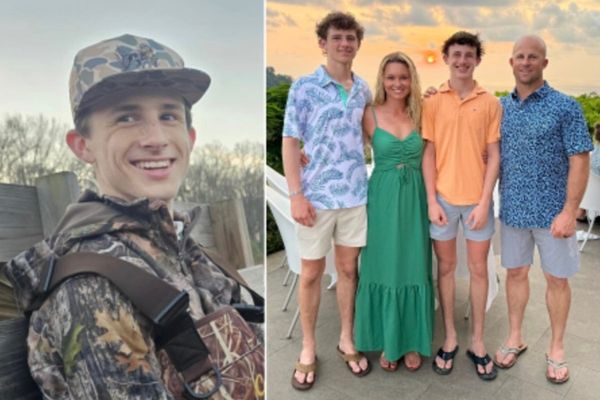
The industrial design studio of robo-taxi company Zoox is tucked behind a password-protected door in an office near San Francisco. Inside, a small team of designers at the Amazon-owned startup have been tinkering with clay, carbon fiber, colors, and fabrics—largely in secret.
On Tuesday morning, Nahuel Battaglia, the team’s original designer, is shyly pointing to his decade-old sketches of the futuristic car he hoped to help build. The old drawings, in many ways, resemble the car that Zoox plans to finally debut for paying riders in Las Vegas later this year or early next in a high-stakes race to catch up to Waymo, the robo-taxi arm of Google’s parent company.
“That was one of our key sketches, that brown and grey sketch up here,” Battaglia says, pointing to a drawing from 2015 that shows a vehicle without a driver's seat, steering wheel, and foot pedals. In another big departure, the front seats face backwards so that passengers face each other like at a cafe table, since no one really needs to be watching the road in a driverless car.

While Waymo has charged for rides in its modified Jaguars in San Francisco and now a few other cities for more than two years, Zoox is less well known. That’s partly because of the company’s decision to keep its vehicles secret for the first six years while its designers tinkered with them. Its cars are also far less frequently on the road for training runs. Currently, the vehicles, which have been compared to cute “toasters” for their boxy shape—are limited to a one-mile route between two Zoox offices in Foster City, Calif., and within a five-mile radius of the company's Las Vegas office, driving at up to 45 miles per hour. Zoox wouldn’t specify exactly how many vehicles it has, nor how many are on the road, though a U.S. National Highway Traffic Safety Administration safety probe suggests it has at least 500 conventional cars retrofitted with its LiDAR technology that helps them navigate autonomously.
On Tuesday, for the first time, Zoox invited a handful of reporters into its design studio to speak with those creating the car and deciding the colors, materials, and finishes that will go into it. Several Zoox staffers were clearly excited to share the rationale behind its green and black color scheme, its sunroof with star-like lights, and the shimmery sound the vehicle makes as the doors open. I caught several Zoox design staffers grinning at their desks as they watched reporters react to the car’s horn, which sounds like a muted train whistle.

Only recently has the team been able to invite outsiders to see what they’ve been working on. In April, Zoox started letting family and friends ride between its Foster City route. While sitting next to me in the prototype vehicle, Chris Stoffel, Zoox’s director of industrial and creative design, told me his family members became emotional when they took a ride for the first time earlier this year. “They cried,” he told me. “I think that they've seen so much investment and time going into developing a product from the ground up,” he said.
Based on the short ride I took in Foster City, there still seem to be kinks to be worked out. Shortly after car started moving, the seat belt tightened aggressively around me, and the vehicle accelerated a little too quickly for my taste. On the way back, I was seated backwards, which is not a particularly good idea for someone like myself who struggles with motion sickness. But the ride itself went smoothly, with the Zoox staying within the road lanes, performing turns, and parking perfectly when the ride ended.
Zoox now employs more than 2,500 people, according to the company, although the team that’s in charge of its industrial design is rather small, with about a dozen to 15 people coming into the studio daily, according to Stoffel. Battaglia, who forgivingly smiled as people repeatedly mispronounced his first name, was the startup’s first industrial designer.
Zoox has continued to tweak its vehicle as it prepares for commercial launch. Karoline Huber, a senior designer at Zoox who's focused on the materials that go into the vehicle, showed off the latest clay and wood model of a Zoox split in half that revealed the lighter green fabrics and finishes of the new design.
The message that Zoox wants to send with its four-seater vehicles is that its robo-taxis are not cars—but should be thought of as a new form of transportation entirely. Perhaps to underscore this point, there are signs in the parking lot designating spots for the Zoox robo-taxis that say. “Robot parking only.”
But it remains to be seen how the public will respond to the futuristic not-car vehicles once they are on the streets in large numbers—and how they will perform when carrying large numbers of passengers.
After all, Waymo has toyed with its own car designs without steering wheels, but has opted to initially deploy cars with driver seats and steering wheels. Meanwhile, GM’s Cruise, which has scaled back its robo-taxi operations after an incident in San Francisco last year in which one of its cars dragged a pedestrian underneath, shelved plans for its so-called Origin after GM CEO Mary Barra said the company “thought it was better to get rid of that risk.”
In practical terms, Zoox is making a big gamble with its steering wheel-free vehicles. The benefit of a steering wheel is that operations staff can easily come to the rescue of an autonomous vehicle that is stuck on city streets and drive it away. In an on-stage interview at Fortune’s Brainstorm Tech conference in July, Zoox CEO Aicha Evans explained that, if a Zoox vehicle gets stuck, it will need to be towed if remote assistance fails to do the job. “That's the worst case scenario,” she said, adding that “those are very rare” instances and that Zoox can, remotely, “give commands to the vehicle to pull over or to take itself to a certain destination.”
Even as Zoox opened the doors to its industrial design studio on Tuesday, the company has retained an element of secrecy to its operation. There were black silk fabric concealing several items in the design studio, including a vehicle prototype. When I asked about them, Stoffel admitted this was because there were reporters around.
“There are other things that may never leave the walls of the studio, so we choose to cover them up,” he said.







